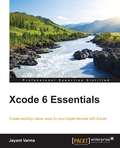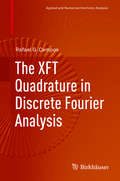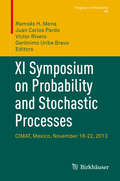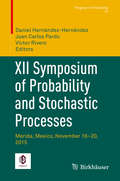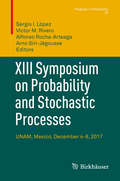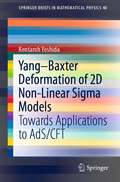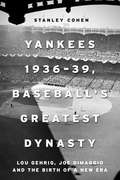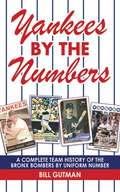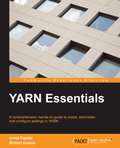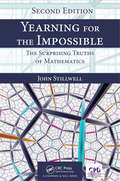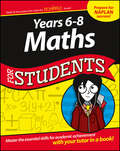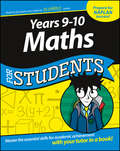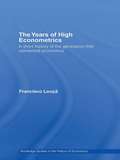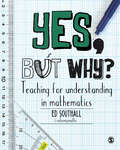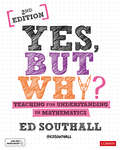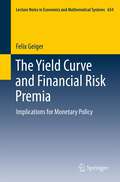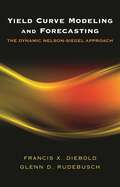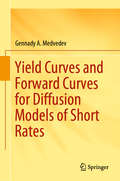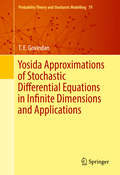- Table View
- List View
X-Parameters
by David E. Root Jan Verspecht Jason Horn Mihai Marcu David E. Root Jan Verspecht Jason HornThis is the definitive guide to X-parameters, written by the original inventors and developers of this powerful new paradigm for nonlinear RF and microwave components and systems. Learn how to use X-parameters to overcome intricate problems in nonlinear RF and microwave engineering. The general theory behind X-parameters is carefully and intuitively introduced, and then simplified down to specific, practical cases, providing you with useful approximations that will greatly reduce the complexity of measuring, modeling and designing for nonlinear regimes of operation. Containing real-world case studies, definitions of standard symbols and notation, detailed derivations within the appendices, and exercises with solutions, this is the definitive stand-alone reference for researchers, engineers, scientists and students looking to remain on the cutting-edge of RF and microwave engineering.
x + y: A Mathematician's Manifesto for Rethinking Gender
by Eugenia ChengA brilliant mathematician examines the complexity of gender and society and forges a path out of inequality.Why are men in charge? After years in the male-dominated field of mathematics and in the female-dominated field of art, Eugenia Cheng has heard the question many times. In x + y, Cheng argues that her mathematical specialty -- category theory -- reveals why. Category theory deals more with context, relationships, and nuanced versions of equality than with intrinsic characteristics. Category theory also emphasizes dimensionality: much as a cube can cast a square or diamond shadow, depending on your perspective, so too do gender politics appear to change with how we examine them. Because society often rewards traits that it associates with males, such as competitiveness, we treat the problems those traits can create as male. But putting competitive women in charge will leave many unjust relationships in place. If we want real change, we need to transform the contexts in which we all exist, and not simply who we think we are.Praise for Eugenia Cheng"[Eugenia Cheng's] tone is clear, clever and friendly . . . she is rigorous and insightful. . . . [She is] a lucid and nimble expositor." --- Alex Bellos, New York Times Book Review "Dr. Cheng . . . has a knack for brushing aside conventions and edicts, like so many pie crumbs from a cutting board."--- Natalie Angier, New York Times
Xcode 6 Essentials
by Jayant VarmaThis book is aimed at developers who want to make applications for Apple devices with Xcode. iOS developers who have experience using other frameworks and languages can now migrate to Xcode and build creative, native apps.
The XFT Quadrature in Discrete Fourier Analysis (Applied and Numerical Harmonic Analysis)
by Rafael G. CamposThis book has two main objectives, the first of which is to extend the power of numerical Fourier analysis and to show by means of theoretical examples and numerous concrete applications that when computing discrete Fourier transforms of periodic and non periodic functions, the usual kernel matrix of the Fourier transform, the discrete Fourier transform (DFT), should be replaced by another kernel matrix, the eXtended Fourier transform (XFT), since the XFT matrix appears as a convergent quadrature of a more general transform, the fractional Fourier transform. In turn, the book’s second goal is to present the XFT matrix as a finite-dimensional transformation that links certain discrete operators in the same way that the corresponding continuous operators are related by the Fourier transform, and to show that the XFT matrix accordingly generates sequences of matrix operators that represent continuum operators, and which allow these operators to be studied from another perspective.
XI Symposium on Probability and Stochastic Processes
by Ramsés H. Mena Juan Carlos Pardo Víctor Rivero Gerónimo Uribe BravoThis volume features a collection of contributed articles and lecture notes from the XI Symposium on Probability and Stochastic Processes, held at CIMAT Mexico in September 2013. Since the symposium was part of the activities organized in Mexico to celebrate the International Year of Statistics, the program included topics from the interface between statistics and stochastic processes.
XII Symposium of Probability and Stochastic Processes: Merida, Mexico, November 16–20, 2015 (Progress in Probability #73)
by Daniel Hernández-Hernández Juan Carlos Pardo Victor RiveroThis volume contains the proceedings of the XII Symposium of Probability and Stochastic Processes which took place at Universidad Autonoma de Yucatan in Merida, Mexico, on November 16–20, 2015. This meeting was the twelfth meeting in a series of ongoing biannual meetings aimed at showcasing the research of Mexican probabilists as well as promote new collaborations between the participants.The book features articles drawn from different research areas in probability and stochastic processes, such as: risk theory, limit theorems, stochastic partial differential equations, random trees, stochastic differential games, stochastic control, and coalescence. Two of the main manuscripts survey recent developments on stochastic control and scaling limits of Markov-branching trees, written by Kazutoshi Yamasaki and Bénédicte Haas, respectively. The research-oriented manuscripts provide new advances in active research fields in Mexico.The wide selection of topics makes the book accessible to advanced graduate students and researchers in probability and stochastic processes.
XIII Symposium on Probability and Stochastic Processes: UNAM, Mexico, December 4-8, 2017 (Progress in Probability #75)
by Sergio I. López Víctor M. Rivero Alfonso Rocha-Arteaga Arno Siri-JégousseThis volume features a collection of contributed articles and lecture notes from the XIII Symposium on Probability and Stochastic Processes, held at UNAM, Mexico, in December 2017.It is split into two main parts: the first one presents lecture notes of the course provided by Mauricio Duarte, followed by its second part which contains research contributions of some of the participants.
Yang–Baxter Deformation of 2D Non-Linear Sigma Models: Towards Applications to AdS/CFT (SpringerBriefs in Mathematical Physics #40)
by Kentaroh YoshidaIn mathematical physics, one of the fascinating issues is the study of integrable systems. In particular, non-perturbative techniques that have been developed have triggered significant insight for real physics. There are basically two notions of integrability: classical integrability and quantum integrability. In this book, the focus is on the former, classical integrability. When the system has a finite number of degrees of freedom, it has been well captured by the Arnold–Liouville theorem. However, when the number of degrees of freedom is infinite, as in classical field theories, the integrable structure is enriched profoundly. In fact, the study of classically integrable field theories has a long history and various kinds of techniques, including the classical inverse scattering method, which have been developed so far. In previously published books, these techniques have been collected and well described and are easy to find in traditional, standard textbooks. One of the intriguing subjects in classically integrable systems is the investigation of deformations preserving integrability. Usually, it is not considered systematic to perform such a deformation, and one must study systems case by case and show the integrability of the deformed systems by constructing the associated Lax pair or action-angle variables. Recently, a new, systematic method to perform integrable deformations of 2D non-linear sigma models was developed. It was invented by C. Klimcik in 2002, and the integrability of the deformed sigma models was shown in 2008. The original work was done for 2D principal chiral models, but it has been generalized in various directions nowadays. In this book, the recent progress on this Yang–Baxter deformation is described in a pedagogical manner, including some simple examples. Applications of Yang–Baxter deformation to string theory are also described briefly.
Yankees 1936–39, Baseball's Greatest Dynasty: Lou Gehrig, Joe DiMaggio and the Birth of a New Era
by Stanley CohenThe Story of the Greatest Yankees Team—and Baseball Team—of All Time New York, 1936. Red Ruffing, Lefty Gomez, Bill Dickey, Lou Gehrig, Tony Lazzeri, and rookie Joe DiMaggio—with these six future Hall of Fame players, the Yankees embarked on a four-year run that would go down in the history books as the greatest Yankees team, if not, the greatest baseball team of all time. Over the next four years, the Yankees won four straight pennants, finishing an average of nearly fifteen games ahead of the second-place team. They won their four World Series by an overall margin of 16-3, sweeping the last two, putting the punctuation mark on baseball’s first true dynasty. Even the Ruthian Yankees of the twenties never won more than two consecutive world championships. From 1936 to 1939, the world was changing rapidly. America was in the grip of the Great Depression. Franklin D. Roosevelt was re-elected president in the greatest landslide in American history. And Hitler’s Germany was on the move in the fall of 1939, just as the Yankee dynasty reached its climax. Against the backdrop of a world in turmoil, baseball, and America’s love for baseball, thrived. Starring the best team of all time, featuring little-known anecdotes of players and set against a history of the world, Yankees 1936–39, Baseball's Greatest Dynasty tells the tale of a legendary team that changed history.
Yankees by the Numbers: A Complete Team History of the Bronx Bombers by Uniform Number
by Bill GutmanWhat do Mark Koenig, Red Rolfe, Frank Crosetti, Sandy Alomar, Bobby Murcer, Wayne Tolleson, and Derek Jeter all have in common? They all wore #2 for the New York Yankees, even though nearly eight decades have passed between the first time Koenig buttoned up a Yankee uniform with that number and the last time Jeter performed the same routine. Since 1929, the Yankees have issued 73 different numbers to more than 1,500 players. That’s a lot of overlap. That also makes for a lot of good stories. Yankees by the Numbers tells those stories for every Yankee since ’29-from Earle Combs (the original #1) to Charlie Keller (the only Yankee to ever wear #99)-providing insightful and humorous commentary about the more memorable players, from a fan’s perspective. Complete with more than 100 baseball cards (courtesy of the Topps Company), each chapter also features a fascinating sidebar that reveals which players were the most obscure to wear a certain number, and also which numbers produced the most wins, home runs and stolen bases in club history. For data seekers, the Yankees Alphabetical Roster is a complete listing of every single Yankee since 1929, the numbers they wore, and their years of service at the House that Ruth Built.
YARN Essentials
by Amol Fasale Nirmal KumarIf you have a working knowledge of Hadoop 1.x but want to start afresh with YARN, this book is ideal for you. You will be able to install and administer a YARN cluster and also discover the configuration settings to fine-tune your cluster both in terms of performance and scalability. This book will help you develop, deploy, and run multiple applications/frameworks on the same shared YARN cluster.
Yearning for the Impossible: The Surprising Truths of Mathematics, Second Edition
by John StillwellYearning for the Impossible: The Surprising Truth of Mathematics, Second Edition explores the history of mathematics from the perspective of the creative tension between common sense and the "impossible" as the author follows the discovery or invention of new concepts that have marked mathematical progress. The author puts these creations into a broader context involving related "impossibilities" from art, literature, philosophy, and physics. This new edition contains many new exercises and commentaries, clearly discussing a wide range of challenging subjects.
Years 6-8 Maths For Students
by Consumer DummiesYour tutor in a book! Master the essential mathematical skills for success! 'I don't know how to do this' is a refrain heard whilst many a student is doing homework. Parents are increasingly called on for assistance, but are themselves struggling to help their children. Years 6-8 Maths For Students is a reference guide for both students and parents, aiming to fill the gaps in a student's knowledge base, build confidence and reduce stress. Written with the same friendly, how-to approach of the successful For Dummies books, this new educational reference will empower students and develop their mathematical skills for exams, NAPLAN testing and, most importantly, life beyond secondary school. With worries that students are being taught to pass tests at the expense of understanding -- this guide will help students cement their mathematical foundations. Grasp the nuts and bolts of numbers, algebra, geometry and measurement Helps students with maths as they transition from primary to secondary school Complete homework and prepare for tests with confidence Save money on expensive tutors. Years 6-8 Maths For Students empowers students to improve their educational outcomes.
Years 9-10 Maths For Students
by Consumer DummiesYour tutor in a book! Master the essential mathematical skills for success! 'I don't know how to do this' is a refrain heard whilst many a student is doing homework. Parents are increasingly called on for assistance, but are themselves struggling to help their children. Years 9-10 Maths For Students is a reference guide for both students and parents, aiming to fill the gaps in a student's knowledge base, build confidence and reduce stress. Written with the same friendly, how-to approach of the successful For Dummies books, this new educational reference will empower students and develop their mathematical skills for exams, NAPLAN testing and, most importantly, life beyond secondary school. With worries that students are being taught to pass tests at the expense of understanding -- this guide will help students cement their mathematical foundations. Grasp the nuts and bolts of numbers, algebra, geometry and measurement. Master simple to complex maths questions, including worded problems Complete homework and prepare for tests with confidence Save money on expensive tutors. Years 9-10 Maths For Students empowers students to improve their educational outcomes.
The Years of High Econometrics: A Short History of the Generation that Reinvented Economics (Routledge Studies in the History of Economics)
by Francisco LouçãA fascinating and comprehensive history, this book explores the most important transformation in twentieth century economics: the creation of econometrics. Containing fresh archival material that has not been published before and taking Ragnar Frisch as the narrator, Francisco Louca discusses both the keys events - the establishment of the Econometric Society, the Cowles Commission and the journal Econometrica – and the major players - economists like Wesley Mitchell, mathematicians like John von Neumann and statisticians like Karl Pearson - in history that shaped the development of econometrics. He discusses the evolution of their thought, detailing the debates, the quarrels and the interrogations that crystallized their work and even offers a conclusion of sorts, suggesting that some of the more influential thinkers abandoned econometrics or became critical of its development. International in scope and appeal, The Years of High Econometrics is an excellent accompaniment for students taking courses on probability, econometric methods and the history of economic thought.
Yes, but why? Teaching for understanding in mathematics
by Ed SouthallGetting the right answers in maths is only half the problem. Understanding why what you’re doing works is the part that often stumps students and teachers alike. Does maths feels like a collection of random rules and steps that somehow lead you to an answer? Don’t worry you’re not alone. Ask yourself: why do we have odd and even numbers? Why do two negative numbers multiply to make a positive? Why do fraction operations work? What is cosine and where does it come from? Yes, but why? answers all of your questions, and sheds light on the hidden connections between everything in mathematics at school. Maths makes sense. It always has, but until now maybe no-one ever showed you. A must-read for those training to teach primary or secondary mathematics via university-based (PGCE, BEd, BA w/QTS) or school-based (School Direct, SCITT, Teach First) routes and current teachers wishing to deepen their mathematical understanding. FIND OUT MORE ABOUT THE AUTHOR BEHIND THE BOOK WITH OUR SPECIAL FEATURE: 60 Seconds with Ed Southall
Yes, but why? Teaching for understanding in mathematics
by Ed SouthallGetting the right answers in maths is only half the problem. Understanding why what you’re doing works is the part that often stumps students and teachers alike. Does maths feels like a collection of random rules and steps that somehow lead you to an answer? Don’t worry you’re not alone. Ask yourself: why do we have odd and even numbers? Why do two negative numbers multiply to make a positive? Why do fraction operations work? What is cosine and where does it come from? Yes, but why? answers all of your questions, and sheds light on the hidden connections between everything in mathematics at school. Maths makes sense. It always has, but until now maybe no-one ever showed you. A must-read for those training to teach primary or secondary mathematics via university-based (PGCE, BEd, BA w/QTS) or school-based (School Direct, SCITT, Teach First) routes and current teachers wishing to deepen their mathematical understanding. FIND OUT MORE ABOUT THE AUTHOR BEHIND THE BOOK WITH OUR SPECIAL FEATURE: 60 Seconds with Ed Southall
Yes, but why? Teaching for understanding in mathematics (Corwin Ltd)
by Ed SouthallGetting the right answers in maths is only half the problem. Understanding why what you’re doing works is the part that often stumps students and teachers alike. The essential guide for mathematics teachers and those training to teach, Yes, but why? answers all your questions, and sheds light on the hidden connections between everything in mathematics at school. This second edition includes: · A new ‘Test yourself’ feature in every chapter · More coverage of the four operations · Enhanced discussion of fractions and proportionality · Downloadable figures for use in the classroom
Yes, but why? Teaching for understanding in mathematics (Corwin Ltd)
by Ed SouthallGetting the right answers in maths is only half the problem. Understanding why what you’re doing works is the part that often stumps students and teachers alike. The essential guide for mathematics teachers and those training to teach, Yes, but why? answers all your questions, and sheds light on the hidden connections between everything in mathematics at school. This second edition includes: · A new ‘Test yourself’ feature in every chapter · More coverage of the four operations · Enhanced discussion of fractions and proportionality · Downloadable figures for use in the classroom
Yet Another Introduction to Analysis
by Victor BryantMathematics education in schools has seen a revolution in recent years. In this book, the author steers a simple and well-motivated path through the central ideas of real analysis. Each concept is introduced only after its need has become clear and after it has already been used informally.
The Yield Curve and Financial Risk Premia: Implications for Monetary Policy
by Felix GeigerThe determinants of yield curve dynamics have been thoroughly discussed in finance models. However, little can be said about the macroeconomic factors behind the movements of short- and long-term interest rates as well as the risk compensation demanded by financial investors. By taking on a macro-finance perspective, the book's approach explicitly acknowledges the close feedback between monetary policy, the macroeconomy and financial conditions. Both theoretical and empirical models are applied in order to get a profound understanding of the interlinkages between economic activity, the conduct of monetary policy and the underlying macroeconomic factors of bond price movements. Moreover, the book identifies a broad risk-taking channel of monetary transmission which allows a reassessment of the role of financial constraints; it enables policy makers to develop new guidelines for monetary policy and for financial supervision of how to cope with evolving financial imbalances.
The Yield Curve and Financial Risk Premia: Implications for Monetary Policy (Lecture Notes in Economics and Mathematical Systems #654)
by Felix GeigerThe determinants of yield curve dynamics have been thoroughly discussed in finance models. However, little can be said about the macroeconomic factors behind the movements of short- and long-term interest rates as well as the risk compensation demanded by financial investors. By taking on a macro-finance perspective, the book’s approach explicitly acknowledges the close feedback between monetary policy, the macroeconomy and financial conditions. Both theoretical and empirical models are applied in order to get a profound understanding of the interlinkages between economic activity, the conduct of monetary policy and the underlying macroeconomic factors of bond price movements. Moreover, the book identifies a broad risk-taking channel of monetary transmission which allows a reassessment of the role of financial constraints; it enables policy makers to develop new guidelines for monetary policy and for financial supervision of how to cope with evolving financial imbalances.
Yield Curve Modeling and Forecasting: The Dynamic Nelson-Siegel Approach (The Econometric and Tinbergen Institutes Lectures)
by Francis X. Diebold Glenn D. RudebuschUnderstanding the dynamic evolution of the yield curve is critical to many financial tasks, including pricing financial assets and their derivatives, managing financial risk, allocating portfolios, structuring fiscal debt, conducting monetary policy, and valuing capital goods. Unfortunately, most yield curve models tend to be theoretically rigorous but empirically disappointing, or empirically successful but theoretically lacking. In this book, Francis Diebold and Glenn Rudebusch propose two extensions of the classic yield curve model of Nelson and Siegel that are both theoretically rigorous and empirically successful. The first extension is the dynamic Nelson-Siegel model (DNS), while the second takes this dynamic version and makes it arbitrage-free (AFNS). Diebold and Rudebusch show how these two models are just slightly different implementations of a single unified approach to dynamic yield curve modeling and forecasting. They emphasize both descriptive and efficient-markets aspects, they pay special attention to the links between the yield curve and macroeconomic fundamentals, and they show why DNS and AFNS are likely to remain of lasting appeal even as alternative arbitrage-free models are developed. Based on the Econometric and Tinbergen Institutes Lectures, Yield Curve Modeling and Forecasting contains essential tools with enhanced utility for academics, central banks, governments, and industry.
Yield Curves and Forward Curves for Diffusion Models of Short Rates
by Gennady A. MedvedevThis book is dedicated to the study of the term structures of the yields of zero-coupon bonds. The methods it describes differ from those usually found in the literature in that the time variable is not the term to maturity but the interest rate duration, or another convenient non-linear transformation of terms. This makes it possible to consider yield curves not only for a limited interval of term values, but also for the entire positive semiaxis of terms. The main focus is the comparative analysis of yield curves and forward curves and the analytical study of their features. Generalizations of yield term structures are studied where the dimension of the state space of the financial market is increased. In cases where the analytical approach is too cumbersome, or impossible, numerical techniques are used. This book will be of interest to financial analysts, financial market researchers, graduate students and PhD students.
Yosida Approximations of Stochastic Differential Equations in Infinite Dimensions and Applications
by T. E. GovindanThis research monograph brings together, for the first time, the varied literature on Yosida approximations of stochastic differential equations (SDEs) in infinite dimensions and their applications into a single cohesive work. The author provides a clear and systematic introduction to the Yosida approximation method and justifies its power by presenting its applications in some practical topics such as stochastic stability and stochastic optimal control. The theory assimilated spans more than 35 years of mathematics, but is developed slowly and methodically in digestible pieces. The book begins with a motivational chapter that introduces the reader to several different models that play recurring roles throughout the book as the theory is unfolded, and invites readers from different disciplines to see immediately that the effort required to work through the theory that follows is worthwhile. From there, the author presents the necessary prerequisite material, and then launches the reader into the main discussion of the monograph, namely, Yosida approximations of SDEs, Yosida approximations of SDEs with Poisson jumps, and their applications. Most of the results considered in the main chapters appear for the first time in a book form, and contain illustrative examples on stochastic partial differential equations. The key steps are included in all proofs, especially the various estimates, which help the reader to get a true feel for the theory of Yosida approximations and their use. This work is intended for researchers and graduate students in mathematics specializing in probability theory and will appeal to numerical analysts, engineers, physicists and practitioners in finance who want to apply the theory of stochastic evolution equations. Since the approach is based mainly in semigroup theory, it is amenable to a wide audience including non-specialists in stochastic processes.


